farm
now browsing by tag
antique
beer
blue
ceramic
character
eagle
early
edition
etched
faience
figural
german
germany
gerz
gift
glass
glazed
hand
king
large
lidded
limited
liter
lithophane
made
mettlach
military
munich
oktoberfest
original
painted
pewter
porcelain
rare
regimental
relief
remy
scene
stein
steins
stoneware
tall
tankard
vintage
westerwald
German Lidded Beer Stein Cut Leaded Glass A Schmidt Farm Horse Rooster

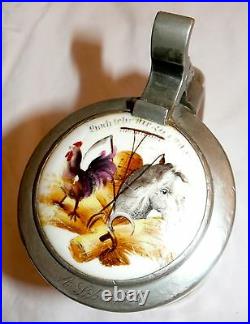
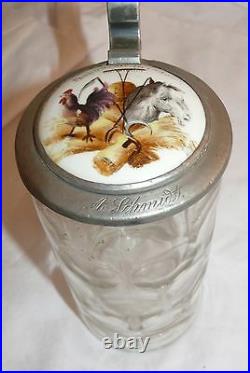


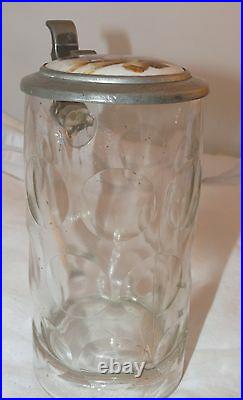
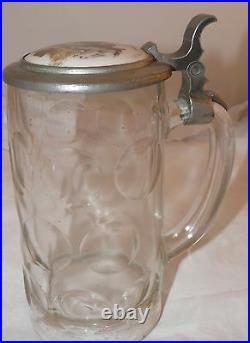
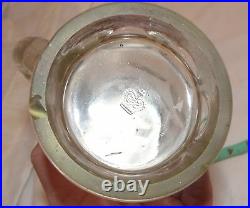


GERMAN LIDDED STEIN CUT LEADED GLASS WITH FIGURAL PORCELAIN LID. SEE PHOTOS FOR GREATER DETAILS. From Wikipedia, the free encyclopedia. This article needs additional citations for verification. Please help improve this article by adding citations to reliable sources. Unsourced material may be challenged and removed. Such Steins may be made out ofstoneware (rarely the inferior earthenware), pewter, porcelain, or even silver, wood or crystal glass; they may have open tops or hinged pewter lids with a thumb-lever. Steins usually come in sizes of a half litre or a full litre (or comparable historic sizes). Like decorative tankards, they are often decorated in a nostalgic manner, but with allusions to Germany or Bavaria. It is believed by some that the lid was implemented during the age of the Black Plague, to prevent diseased fleas from getting into the beer. 4 Other forms and synonyms. Common half-litre Humpen or beer mug. Stein is an abbreviation of German Steingut “stoneware”, [2] the common material for beer mugs before the introduction of glass. The word is not used within Germany. The word stein could have also originated from the German word Steinzeugkrug, meaning stoneware jug or tankard. By common usage, stein is referred to being a beer container with a handle and hinged lid. Bierstein in German means beerstone i. Beer scale a hard residue of calcium oxalate, protein, and sugar formed when a brewing vessel is used repeatedly without exacting cleaning. The stein originated around the 14th century. The spread of the bubonic plague throughout Europe forced Germany to take some precautions in preventing a catastrophe. A new German law was written, stating that all beverage containers needed a lid. During the next 300 or so years, Germany enforced many regulations on how their beer was to be produced and transported, while other European countries didn’t take such precautions. Thus German beer quickly became popular across Europe and demand for the beer increased as well. This demand made it a necessary search for inexpensive, yet durable material to transport large amounts of beer to different areas. Although many materials proved to be a sufficient material to use in creating beer steins, the most common materials used were glass, stoneware, and porcelain. In the latter half of the 19th century, stein makers found different advantages within the different materials. The advantage in using stoneware to make steins was that molds could be used to mass produce elaborately carved steins. In using glass, not only could one produce multiple glass mugs, but an artistic touch could add to the glass by including acid etchings, glass staining, or even multicolored overlays. Porcelain’s advantage was that a stein fabricator could use molds to make “character steins”, steins that had a particular shape modeled after an item or a person. Throughout the 1900s, collecting antique and replicated beer steins became very popular hobby not only among individual people, but in museums as well. Production of beer steins has become substantially large in America, but the largest producer of beer steins is Ceramarte of Brazil. The most traditional area of beer stein production is the Westerwald region in Germany called “Kannenbaeckerland”. This unique German potters region has been creating beer steins for centuries and is famous among the collectors as the original German beer stein producer. Beer steins were made primarily with pewter in many areas across Europe (primarily in England), but many steins were known to be made of glass, porcelain, and silver as well. [4] [5] Steins has also been known to have been forged out of wood, earthenware, and crystal. Ordinary German beer mugs have been made out of glass for hygienic reasons since the introduction of glass mugs to the 1892 Oktoberfest. Modern beer mugs, except again decorative or luxury versions, don’t have a lid. Beer mugs (0.5 and 1 litre) are typical for beer gardens and especially the Oktoberfest, where they are popular for their robustness. In other settings, 0.33 and 0.5 litre beer glasses are also popular. [edit]Other forms and synonyms. In German-speaking regions beer mugs may be known as. Maßkrug or Maß (for a one-litre beer mug). Adlerhumpen, a tall drinking glass sometimes with covers enamelled with the double eagle of the Holy Roman Empire. Seidel or Seidla (Franconia, ½ litre). The term “Seidel” is also used by the Deitsch in the Deitscherei. Schoppen (Palatinate, ½ litre). Keferloher, the traditional (but non-embellished) stoneware beer mug, named after the village of Keferloh near Munich where they were originally produced. Considered collectible are traditional designs such as brewery emblems, Bavarian motifs such as Neuschwanstein or the Marienplatz Rathaus-Glockenspiel of Munich, and the colorful official annual Oktoberfest souvenir mug featuring the year’s winning poster design. The use of beer mugs is uncommon in most parts of Northern and Central Germany, and in these regions considered a Bavarian specialty. Unusually large German beer stein (31.99 litre capacity, 15.88kilos empty). Although they have long gone out of fashion, the lids on beer mugs serve as a sanitary measure especially to keep insects out of the beer. They are usually made out of pewter, and are usually equipped with a lever that is in reach of the thumb, so that it is possible to grab the mug and open and close the lid with a single hand (if one can hold the weight, that is). These days beer mats are usually used to cover the glass or mug when required. The item “GERMAN LIDDED BEER STEIN CUT LEADED GLASS A SCHMIDT FARM HORSE ROOSTER” is in sale since Sunday, March 20, 2016. This item is in the category “Collectibles\Breweriana, Beer\Drinkware, Steins\Lidded Steins\Germany”. The seller is “lhowardestates” and is located in Minneapolis, Minnesota. This item can be shipped to United States, Canada, United Kingdom, Denmark, Romania, Slovakia, Bulgaria, Czech republic, Finland, Hungary, Latvia, Lithuania, Malta, Estonia, Australia, Greece, Portugal, Cyprus, Slovenia, Japan, China, Sweden, South Korea, Indonesia, Taiwan, South africa, Thailand, Belgium, France, Hong Kong, Ireland, Netherlands, Poland, Spain, Italy, Germany, Austria, Bahamas, Israel, Mexico, New Zealand, Philippines, Singapore, Switzerland, Norway, Saudi arabia, Ukraine, United arab emirates, Qatar, Kuwait, Bahrain, Croatia, Malaysia, Brazil, Chile, Colombia, Costa rica, Panama, Trinidad and tobago, Guatemala, Honduras, Jamaica, Antigua and barbuda, Aruba, Belize, Dominica, Grenada, Saint kitts and nevis, Saint lucia, Montserrat, Turks and caicos islands, Barbados, Bangladesh, Bermuda, Brunei darussalam, Bolivia, Ecuador, Egypt, French guiana, Guernsey, Gibraltar, Guadeloupe, Iceland, Jersey, Jordan, Cambodia, Cayman islands, Liechtenstein, Sri lanka, Luxembourg, Monaco, Macao, Martinique, Maldives, Nicaragua, Oman, Peru, Pakistan, Paraguay, Reunion, Viet nam, Uruguay, Russian federation.

 D5 Creation
D5 Creation